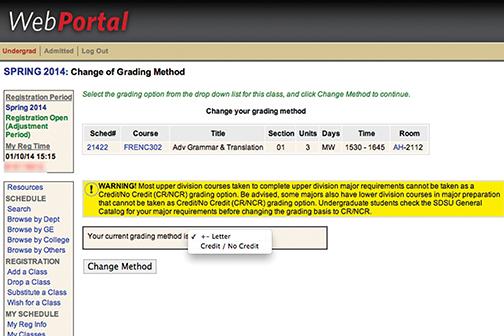I was surprised at how few of my friends at San Diego State take classes for credit/no credit. Considering you only need a C to receive credit for a class, credit/no credit is a viable option for any student who is looking to pass a class, but isn’t willing to completely devote his or her time to it. It’s certainly a great option for those busy students who are trying to balance school, a job, extracurricular activities and a social life. But before I delve into a discussion on the perks of using this grading system, you should know about its shortcomings.
First and most importantly, you can’t take a class credit/no credit if it fulfills upper division major or minor requirements, unless the class is only offered as credit/no credit class. In fact, you’ll get an obnoxious warning that reminds you when you try to switch the grading system. It actually makes perfect sense that you shouldn’t be able to use this grading system for major or minor requirements; you’re supposed to at least be adequate in your own field of study.
Additionally, if you’re planning on going to graduate school, then you should know that many graduate programs will treat a no credit grade as a big, fat F. That will most certainly impact your GPA, and more importantly, your chances of getting accepted. Ultimately, a C- would be more justifiable than a no credit grade that would eventually be treated as an F down the road. Even when you’re in graduate school, at least at SDSU, 70 percent of the units used to fulfill the minimum requirements on a master’s degree program must be letter graded.
And last but not least, you might end up taking a class for credit/no credit and become so infatuated with it you decide to major or minor in that field of study. You then realize that you’ve made a huge mistake by taking the class credit/no credit. What you’ll end up doing is having to retake the course, for a letter grade. This one hits a little too close to home.
This happened to me in November 2012 when I was taking two geography classes to fulfill general education requirements and suddenly decided to make it my minor. But since I was taking one of the classes for credit/no credit, it wouldn’t count toward my geography minor if I passed the class, but it wouldn’t hurt my GPA if I failed. [quote] I was in a psychological limbo knowing that at that I couldn’t do anything to receive a letter grade, but at least my GPA wouldn’t suffer from not receiving credit.[/quote] But don’t let any of these reasons discourage you from taking a class credit/no credit since the positives definitely outweigh the negatives.
The ideal situation for credit/no credit is for general education classes and electives. We all have to deal with these classes, but we don’t all want to. There’s already an “I-just-need-to-pass” mentality behind most students taking general education classes, so why not mitigate the situation? Instead of worrying about a C bogging down your GPA, you can take the class credit/no credit, get credit for the units and fulfill the general education requirements without worrying about your GPA being affected. Keep in mind that you can do this for both lower-division and upper-division general education requirements.
As for electives, let’s say you’re taking all the classes you need, but you’re short on being considered a full-time student (for financial aid or other reasons). You’ll most likely enroll in elective classes just to be considered full-time, but you don’t necessarily want to put in extra effort in the elective class since it’s just a filler. Take the class credit/no credit instead; the credit/no credit system is ideal for general education classes and electives.
The benefits of credit/no credit are rewarding. It’s psychologically comforting knowing that you “just have to pass.” You won’t be pulling all-nighters for these classes and you won’t feel as guilty for ditching (which I’m not at all condoning). In fact, one research study conducted on medical students by Mayo Clinic found that medical students taking classes for credit/no credit (or pass/fail as described in the paper) experienced less perceived stress and were in a better mood when compared with students who were graded using the traditional five-letter grading system.
Credit/no credit allows you to prioritize your time for your classes, especially if you’re knee deep in your major or minor classes that you have to take for a letter grade. [quote]It’s a safety cushion. It’s the minimum amount of effort for the maximum result. It’s a blessing disguised as a grading system.[/quote]
Undergraduates are only allowed to take 15 units for credit/no credit, which is equivalent to five three-unit classes. However, that’s not to say that you won’t have to work hard to pass–they’re not 15 free units just for you to take. You’ll still work for the units, you’ll just be happier doing it. So with the 15-unit limit in mind, remember to choose wisely and don’t let that 15-unit blessing go to waste.










